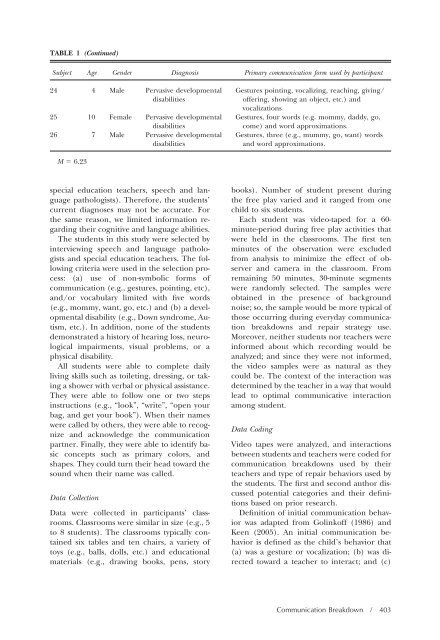Education and Training in Autism and Developmental Disabilities
Education and Training in Autism and Developmental Disabilities
Education and Training in Autism and Developmental Disabilities
Create successful ePaper yourself
Turn your PDF publications into a flip-book with our unique Google optimized e-Paper software.
TABLE 1 (Cont<strong>in</strong>ued)<br />
Subject Age Gender Diagnosis Primary communication form used by participant<br />
24 4 Male Pervasive developmental<br />
disabilities<br />
25 10 Female Pervasive developmental<br />
disabilities<br />
26 7 Male Pervasive developmental<br />
disabilities<br />
M 6.23<br />
special education teachers, speech <strong>and</strong> language<br />
pathologists). Therefore, the students’<br />
current diagnoses may not be accurate. For<br />
the same reason, we limited <strong>in</strong>formation regard<strong>in</strong>g<br />
their cognitive <strong>and</strong> language abilities.<br />
The students <strong>in</strong> this study were selected by<br />
<strong>in</strong>terview<strong>in</strong>g speech <strong>and</strong> language pathologists<br />
<strong>and</strong> special education teachers. The follow<strong>in</strong>g<br />
criteria were used <strong>in</strong> the selection process:<br />
(a) use of non-symbolic forms of<br />
communication (e.g., gestures, po<strong>in</strong>t<strong>in</strong>g, etc),<br />
<strong>and</strong>/or vocabulary limited with five words<br />
(e.g., mommy, want, go, etc.) <strong>and</strong> (b) a developmental<br />
disability (e.g., Down syndrome, <strong>Autism</strong>,<br />
etc.). In addition, none of the students<br />
demonstrated a history of hear<strong>in</strong>g loss, neurological<br />
impairments, visual problems, or a<br />
physical disability.<br />
All students were able to complete daily<br />
liv<strong>in</strong>g skills such as toilet<strong>in</strong>g, dress<strong>in</strong>g, or tak<strong>in</strong>g<br />
a shower with verbal or physical assistance.<br />
They were able to follow one or two steps<br />
<strong>in</strong>structions (e.g., “look”, “write”, “open your<br />
bag, <strong>and</strong> get your book”). When their names<br />
were called by others, they were able to recognize<br />
<strong>and</strong> acknowledge the communication<br />
partner. F<strong>in</strong>ally, they were able to identify basic<br />
concepts such as primary colors, <strong>and</strong><br />
shapes. They could turn their head toward the<br />
sound when their name was called.<br />
Data Collection<br />
Data were collected <strong>in</strong> participants’ classrooms.<br />
Classrooms were similar <strong>in</strong> size (e.g., 5<br />
to 8 students). The classrooms typically conta<strong>in</strong>ed<br />
six tables <strong>and</strong> ten chairs, a variety of<br />
toys (e.g., balls, dolls, etc.) <strong>and</strong> educational<br />
materials (e.g., draw<strong>in</strong>g books, pens, story<br />
Gestures po<strong>in</strong>t<strong>in</strong>g, vocaliz<strong>in</strong>g, reach<strong>in</strong>g, giv<strong>in</strong>g/<br />
offer<strong>in</strong>g, show<strong>in</strong>g an object, etc.) <strong>and</strong><br />
vocalizations<br />
Gestures, four words (e.g. mommy, daddy, go,<br />
come) <strong>and</strong> word approximations.<br />
Gestures, three (e.g., mummy, go, want) words<br />
<strong>and</strong> word approximations.<br />
books). Number of student present dur<strong>in</strong>g<br />
the free play varied <strong>and</strong> it ranged from one<br />
child to six students.<br />
Each student was video-taped for a 60m<strong>in</strong>ute-period<br />
dur<strong>in</strong>g free play activities that<br />
were held <strong>in</strong> the classrooms. The first ten<br />
m<strong>in</strong>utes of the observation were excluded<br />
from analysis to m<strong>in</strong>imize the effect of observer<br />
<strong>and</strong> camera <strong>in</strong> the classroom. From<br />
rema<strong>in</strong><strong>in</strong>g 50 m<strong>in</strong>utes, 30-m<strong>in</strong>ute segments<br />
were r<strong>and</strong>omly selected. The samples were<br />
obta<strong>in</strong>ed <strong>in</strong> the presence of background<br />
noise; so, the sample would be more typical of<br />
those occurr<strong>in</strong>g dur<strong>in</strong>g everyday communication<br />
breakdowns <strong>and</strong> repair strategy use.<br />
Moreover, neither students nor teachers were<br />
<strong>in</strong>formed about which record<strong>in</strong>g would be<br />
analyzed; <strong>and</strong> s<strong>in</strong>ce they were not <strong>in</strong>formed,<br />
the video samples were as natural as they<br />
could be. The context of the <strong>in</strong>teraction was<br />
determ<strong>in</strong>ed by the teacher <strong>in</strong> a way that would<br />
lead to optimal communicative <strong>in</strong>teraction<br />
among student.<br />
Data Cod<strong>in</strong>g<br />
Video tapes were analyzed, <strong>and</strong> <strong>in</strong>teractions<br />
between students <strong>and</strong> teachers were coded for<br />
communication breakdowns used by their<br />
teachers <strong>and</strong> type of repair behaviors used by<br />
the students. The first <strong>and</strong> second author discussed<br />
potential categories <strong>and</strong> their def<strong>in</strong>itions<br />
based on prior research.<br />
Def<strong>in</strong>ition of <strong>in</strong>itial communication behavior<br />
was adapted from Gol<strong>in</strong>koff (1986) <strong>and</strong><br />
Keen (2005). An <strong>in</strong>itial communication behavior<br />
is def<strong>in</strong>ed as the child’s behavior that<br />
(a) was a gesture or vocalization; (b) was directed<br />
toward a teacher to <strong>in</strong>teract; <strong>and</strong> (c)<br />
Communication Breakdown / 403

















